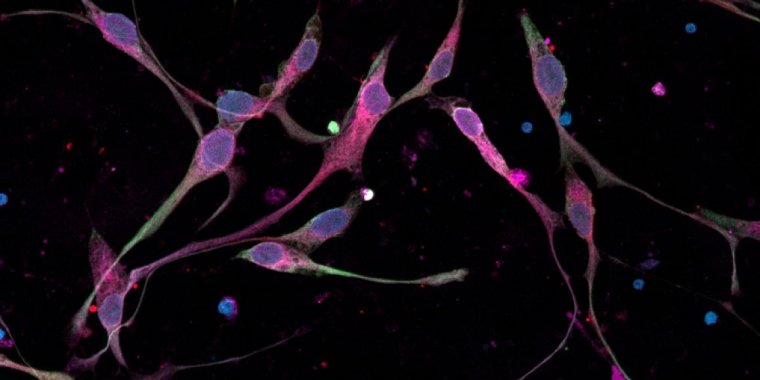| Health / Health News |
Scientists find promising drug combination against lethal childhood brain cancers
Researchers have devised a new plan of attack against a group of deadly childhood brain cancers collectively called diffuse midline gliomas (DMG), including diffuse intrinsic pontine glioma (DIPG), thalamic glioma and spinal cord glioma.

A confocal micrograph shows DIPG cells, grown from patient cells, in culture. The cells are expressing several proteins, including: DAPI (blue, in the cell nuclei); vimentin (red, a protein marker of neural stem/precursor cells and glioma cells); and Nestin (green, also a protein marker of neural stem/precursor cells and glioma cells). Photo: Shawn Gillespie/Monje Laboratory/Stanford Medicine
Scientists at the National Institutes of Health, Stanford University, California, and Dana-Farber Cancer Institute, Boston, identified a drug pair that worked together to both kill cancer cells and counter the effects of a genetic mutation that causes the diseases.
The researchers showed that combining the two drugs – panobinostat and marizomib – was more effective than either drug by itself in killing DMG patient cells grown in the laboratory and in animal models. Their studies also uncovered a previously unrecognized vulnerability in the cancer cells that scientists may be able to exploit to develop new strategies against the cancer and related diseases.
DMGs are aggressive, hard-to-treat tumors that represent the leading cause of brain cancer-related death. DMGs typically affect a few hundred children a year between ages 4 to 12; most children die within a year of diagnosis. Most cases of DMG are caused by a specific mutation in histone genes.
Histones are protein complexes in the cell nucleus. DNA wraps around histones to form chromatin, which packages DNA in the nucleus. How DNA winds and unwinds around histones is influenced by enzymes, including histone deacetylases. These enzymes add or remove chemical tags, which indirectly controls if genes are turned on or off.
In an earlier study, Stanford neuro-oncologist Michelle Monje. M.D., Ph.D., and her colleagues showed that panobinostat, which blocks key histone deacetylase enzymes, could restore the DIPG histone function to a more normal state.
While panobinostat is already in early clinical testing in DIPG patients, its usefulness may be limited because cancer cells can learn to evade its effects. So Monje’s team wanted to identify other possible drugs – and combinations of them – that could affect the cancer.
“Very few cancers can be treated by a single drug,” said Monje, a senior author of the study who treats children with DIPG and other diffuse midline gliomas. “We’ve known for a long time that we would need more than one treatment option for DIPG. The challenge is prioritizing the right ones when there are thousands of potential options. We’re hopeful that this combination will help these children.”
The NIH’s National Center for Advancing Translational Sciences (NCATS) researchers first studied the effects of single approved drugs and investigative compounds on DIPG cell models grown in the laboratory from patient cells.
They focused on agents that could both kill DIPG cells and cross the brain’s protective blood-brain barrier, a necessity for a drug to be effective against DIPG in patients. The team then tested the most effective single agents in various combinations.
While there were multiple, promising outcomes from these screens, the team focused on the combination of histone deacetylase inhibitors (like panobinostat) with drugs called proteasome inhibitors (such as marizomib). Proteasome inhibitors block cells’ normal protein recycling processes.
The panobinostat-marizomib combination was highly toxic to DIPG cells in several models, including DIPG tumor cell cultures that represented the main genetic subtypes of the disease and mice with cells transplanted from patient tumors. The combination also reduced tumor size in mice and increased their survival.
A similar response was found in spinal cord and thalamic DMG models developed from cells grown in culture from patient cells.
The screening studies also provided important clues to the ways the drugs were working. Building on these data, the collaborative team subsequently conducted a series of experiments that showed the DIPG cells responded to these drugs by turning off a biochemical process in the cell’s mitochondria that is partly responsible for creating ATP, which provides energy to cells.
The drug combination essentially shuts down tumor cell ATP production. (National Institutes of Health)
YOU MAY ALSO LIKE





